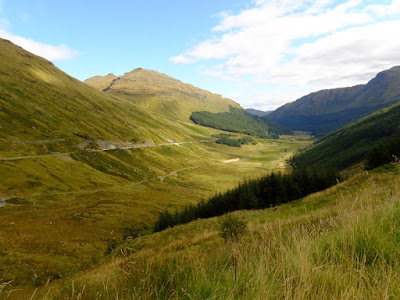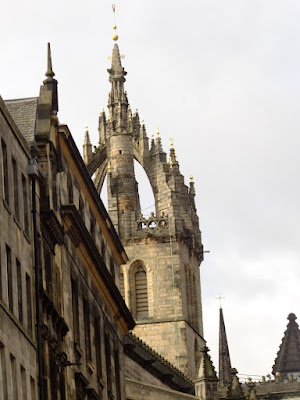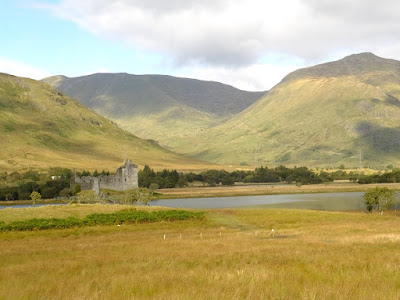 |
| The Scottish Highlands are absolutely idyllic. |
More than forty years ago, I visited the United Kingdom with my parents and my brothers. We spent a few days in Edinburgh, including New Year's Eve, (a day Edinburgh is known to celebrate in lively fashion), but I can't remember much about our visit to Scotland's capital city. I think maybe we all had bad colds and stayed huddled in our hotel rooms. This time, things would be different.
One of those aforementioned brothers and his wife had planned to travel to Edinburgh from Pennsylvania two years ago, but the pandemic delayed their trip. They were finally able to travel across the pond, so my sister and I, along with our husbands, invited ourselves to meet up with them in Scotland.
 |
| Edinburgh Castle is perched above Edinburgh's lively Grassmarket neighborhood. |
 |
| St. Giles' Cathedral, also known as the High Kirk of Edinburgh, isn't actually a cathedral. |
We base ourselves in Edinburgh, which is a great city with oodles of brutal history. But our side trips turn out to be some of the week's highlights.
 |
| Our tour makes a short stop for photos of Castle Kilchurn, set in the middle of a loch. |
We have a few days before the family arrives, so after our requisite Day One walking tour of city, we spend our second day on a Timberbush bus tour of the West Highlands and Loch Lomond. Our driver/guide is terrific, and the scenery is incredible.
 |
| What beautiful weather for visiting the Scottish Highlands! |
Our first stop is at Doune Castle. We enjoy our visit but are a wee bit underwhelmed: We have many more impressive châteaux near our home in France, and we've never seen the TV show "Outlander," where this particular castle is featured.
 |
| Inveraray is located on the western shore of Loch Fyne. |
Later in the day we have a two-hour stop in Inveraray. This time we skip the castle and find an offbeat garden restaurant for lunch and a spot of single malt. I have been especially looking forward to our visit to Loch Lomond, a place I had romanticized because of the song. We only get to see one small part of the huge lake, and it's not quite as dazzling as I had anticipated, but I am thrilled to stand on its bonnie bonnie banks with my true love.
 |
| We pose on the bonnie bonnie banks of Loch Lomond. |
Throughout the day, our guide tells us all about Scottish history and in great detail debunks everything depicted in the film "Braveheart." His narration is fascinating and the landscape is spectacular.
The nine-hour ride allows us to rest up before spending the next five days on our feet. Edinburgh has a great public transit system, but we opt to walk everywhere. It's about a 10-minute walk from our apartment to the start of The Royal Mile, the road that runs between the Palace of Holyroodhouse (the official residence of the Queen King) and Edinburgh Castle, a grand love letter to war and weaponry.
 |
| A sphinx rests atop the Royal Scottish Academy in Edinburgh. |
 |
| We aren't able to crack the code on the Canongate Tolbooth clock on Edinburgh's Royal Mile. |
 |
| Here's a view across Edinburgh toward Leith Harbor from Edinburgh Castle. |
 |
| We prefer to stroll the grounds of Edinburgh Castle rather than lingering at the military exhibits. |
 |
| I wonder where a cannonball shot from Edinburgh Castle would land. |
 |
| I'm dwarfed by this sailor standing alongside the Royal Yacht Britannia. |
On Day 3 we walk to Leith harbor and visit the Royal Yacht Britannia. Our self-guided tour of the yacht is surprisingly interesting. Who knew that the royal beds would be so small, or that the royal family traveled with about four tons of luggage and a crew of more than 200? Today, private parties can book the yacht for fancy soirées where all the food is prepared onboard in really tiny kitchens.
 |
| The living room aboard the Britannia is dotted with game tables. |
 |
| Dining room tables of the Britannia are set with precision and care. |
 |
| Crew quarters aboard the Britannia billeted more than 200 sailors and staff. |
 |
| The National Museum of Scotland's natural history gallery contains hundreds of animals. |
The major museums in Edinburgh are free, and we spend a few hours at the Scottish National Museum, which includes natural history, technology, culture, and a whole wing of Scottish history. We spend most of our time in the animal and tech sections. If you go there, check out the view from the roof.
 |
| We've asked this robot to spell our pseudonym with blocks. |
On our last full day, we take a short train ride to the seaside village of North Berwick. In addition to a leisurely stroll without crowds or traffic, we enjoy a good lunch and my husband treats himself to a Turkish hot towel shave.
 |
| The seaside town of North Berwick upon the Firth of Forth is home to the Scottish Seabird Centre. |
 |
| This kirkyard in North Berwick is adjacent to the Parish Kirk, also known as St. Andrew's Church and the Old Parish Kirk. |
Speaking of food, I am impressed that nearly every restaurant in which we eat offers a menu with several vegetarian and vegan options. I have no desire to try the haggis, but I do try the vegan haggis eggs Benedict on crumpets. Now, there's a dish I'd never find anywhere else!
 |
| I'm compelled to order the vegan haggis Benedict at Mimi's Bakehouse in Edinburgh. |
 |
| Our favorite sign in Edinburgh is found at this hotdog stand along the Royal Mile. |



























.jpg)


